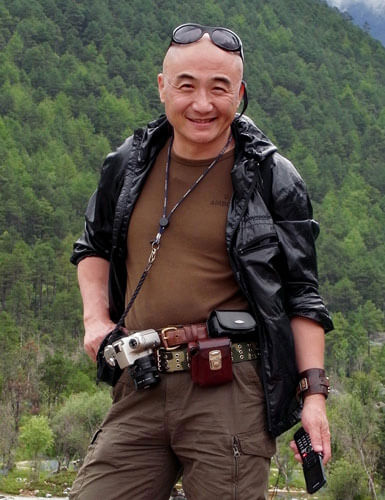Wang Wusheng was born in the city of Wuhu in China's Anhui Province and graduated from Anhui University's School of Physics. Beginning in 1973, Wusheng worked as a photographer for a news magazine in Anhui Province. He studied at the Art Institute of Nihon University in Japan beginning in 1983 and studied for three years at the Tokyo Arts University. Wusheng currently works as a fine art photographer in Tokyo.
For more than three decades, Wang Wusheng has been captivated by the beauty of Mount Huangshan, also called Yellow Mountain. Located in the southern part of the Anhui province in northern China, Mount Huangshan has often been described as the world's most beautiful and enchanting mountain. Over many centuries, this mountain, with its seventy-two peaks, has been the subject of Chinese landscape painters, whose singular works are so haunting make it appear impossible for these mountains to exist in nature. Inspired by the legacy of these paintings, Wusheng has sought to portray Mount Huangshan in his own way, expressing his "inner worlds" through this scenic wonder.
Wusheng captures mist-shrouded granite peaks emerging from an ever-changing veil of clouds, sculptural craggy rocks on lofty cliffs and weathered, oddly shaped pine trees. He records the appearance of Mount Huangshan in all seasons and at various times of day. As one critic says, "[Wusheng's] pictures are gorgeous, but their beauty does not come directly from the natural scenery. Rather, the mountain's natural wonders have been transformed into artistic spectacles through the artist's commitment to the medium of black-and-white photography, his insistent pursuit of dynamic movement and metamorphic images, and his deep emotional engagement with his subject. His mountain peaks are often densely dark-a kind of velvet darkness that seems full of color."
Source: Robert Klein Gallery
World-renowned photographer, writer, and broadcaster Tom Ang wrote in 2014 in his book
Photography: The Definitive Visual History published by DK this text about Wang Wusheng's art works:
Oriental perspectives
The fusion of classical Chinese fine art with photography was not achieved until the 1940s. It resulted in a distinctive approach to landscape by combining classical forms with a challenge to the Western representation of space.
Photography had reached China and Japan by the 1840s, but long remained an imported art form used primarily by foreigners. Fundamentally it was alien to the aesthetics of Asian fine art. The fine detail of a photograph was at odds with the eastern tradition of depicting a scene with just a few brushstrokes. And whereas Eastern art dealt with symbols-mountains representing wisdom, water standing for the flux of life and so on- photography seemed unremittingly literal and heavy-handed to Asian eyes. Eastern art was also fixedly monochrome: black was Heaven's hue, and too much considered bad for the eyes.
Three dimensions in two
A further element foreign to Asian minds was the handling of perspective-how three-dimensional space was represented on the flat surface of a print or painting. In Europe, 15th-century thinkers, such as the architect Filippo Brunelleschi, showed that a geometrically accurate way to represent objects in space was to depict parallel sides as if they converged toward a vanishing point on the horizon. Early photography reinforced the dominance of this linear perspective in Western art.
Classical Asian art was based on different models of space. It showed space with receding planes, in which a nearer object overlaps and covers part of a further object. This was joined to aerial perspective, which exploits how contrast and clarity naturally diminish the further away things are to express receding space.
Asian pictorials
By the 20th century. even artists in he West were rebelling against geometrical perspective, most visibly in the Cubist movement, which spilled over to montage effects in modernist photography (see pp. 142-43 and Pp.330-31). Finally, in the 1940s, Long Chin-San (also transliterated Lang Jingshan) in Hong Kong marked the first successful fusion of Asian with European modes. Trained in Photography by a brush-and-ink artist, Long considered a traditional painting "as a composite Image of fragmentary visual memories".
From this, Long derived composite photographs using subtle toning and multiple printing techniques to place traditional elements such as calligraphically expressive bamboo shoots, leafless branches, and craggy rocks against a plain ground, suspending his subjects In an indeterminate space. Relationships between elements were defined by aerial perspective and overlapping receding planes. Minimal and calligraphic expressions also came naturally to photographers such as Jiang Peng, but Long's best-known students was Don Hong Qai.
Modern interpretation
China's Huangshan (Yellow Mountains) is a glaciated mountain range much venerated for its exquisite scenery of 72 steep peaks, often shrouded in mist. The Huangshan inspired its own school of painting, which made extensive use of aerial perspective, Wang Wusheng is a leading modern exponent of the style.
Wang was working as a news photographer when he turned his attention to the Huangshan in 1973 In his photographs, he exploited the ultrafine grain of Kodak Technical Pan film to create a modern interpretation of inky-black silhouettes are grouped against the smoothly shifting swathes of mist, their softening tones deftly defining distance.
This image is part of the Celestial Realm series, published in book form in 2005. In wang's contemporary interpretation of traditional Chinese black-ink painted landscapes, mist separates the deep velvety darkness of the sharply silhouetted rocks and trees in the foreground from the progressively fuzzier bands of trees and rocks.
